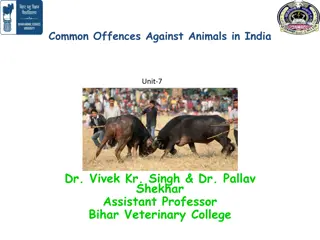Common Offences Against Animals in India: Overview and Consequences
There are three common offences against animals in India: mischief, cruelty, and bestiality. Mischief involves killing, poisoning, or harming animals, punishable under IPC Sections 428 and 429. Cruelty includes acts like beating, overloading, and starvation, regulated by the Prevention of Cruelty to Animals Act, 1960. Bestiality refers to unnatural carnal intercourse with animals, often influenced by cultural beliefs and mental abnormalities. Examination methods for bestiality offenders involve checking for injuries and spermatozoa presence in animals.
Download Presentation

Please find below an Image/Link to download the presentation.
The content on the website is provided AS IS for your information and personal use only. It may not be sold, licensed, or shared on other websites without obtaining consent from the author. Download presentation by click this link. If you encounter any issues during the download, it is possible that the publisher has removed the file from their server.
E N D
Presentation Transcript
M.V.Sc Programme:VPP 612 COMMON OFFENCES AGAINST ANIMALS IN INDIA Dr. ImranAli Assistant Professor Veterinary Pathology, BVC, Patna
COMMON OFFENCES AGAINST ANIMALS IN INDIA There are three common offences against animals in India; mischief, cruelty against animals and bestiality.
Mischief This includes killing, poisoning or maiming an animal. Poisoning is the commonest method of mischievous killing of an animal. Abrus precatorius arsenic, root, snake venom, datura leaves and seeds of yellow oleander are common poisons used in the mischievous killing of the animals. Accidental poisoning may occur in animals by linseed or jowar poisoning. Mischief is punishable under Section 428 and 429 IPC.
Mischief a) Fracture of bone. b) Cutting tendons of legs and neck. c) Injury to udder in milch animals. d) Fearing of the vagina or rectum by introducing sharp or blunt object. e) Punctured wounds etc.
Cruelty against animals This offence includes beating, overloading, using a diseased animal for work, starvation, Phuka method etc. These acts are punishable under the Prevention of Cruelty to Animals Act, 1960.
Bestiality Bestiality means carnal intercourse with man, women, or animal against the order of nature. This type of crime is more frequently found in India due to the following reasons: a) The common belief among illiterate people that intercourse with a she- donkey is remedy for gonorrhoea. b) Excessive sexual desire with less opportunity for natural intercourse. c) Young villagers who go out to graze cattle in fields far away from human eye, are incited, owing to loneliness and the proximity of animals, to commit this crime. d) People having some mental abnormalities. In bestiality the human male is generally the active agent and the passive agent is a she-goat, donkey, mare, cow or even hen. No cases of the human female being involved in similar manner are publicly known.
EXAMINATION OF ANIMAL FOR BESTIALITY a) The offenders are usually caught red-handed. b) The vagina of animal should be examined for evidence of injury and the accused examined for marks of injuries caused by the kicks, teeth or claws of animal. c) The surrounding hairs of the animal should be examined for the presence of human spermatozoa. (this is very important to note that the spermatozoa found are of the same animal or not, for this purpose the presence or absence of heat in the female animal is also a guide). d) The presence of organisms of gonorrhoea in the vagina of the animal is a sure sign of bestiality. e) The clothes of accused will give off a smell of urine or faeces of the animals as after a sexual act animals have a habit of urinating. Bestiality is punishable under Section 377 I.P.C.
EXANIMATION OF SEMINAL STAINS In the case of bestiality, it is essential to determine presence of human seminal fluid in or around the parts of the animal. Detection of human spermatozoa in a smear from the vagina of the animal and that from the discharge adhering to the surrounding hairs is a positive proof of the offence. The examination of seminal stains may be carried out by the following methods; physical, chemical, Microscopic and Serological.
EXAMINATION OF ANIMAL FOR BESTIALITY a) Physical Examination: - The physical characteristics of fresh semen of different animals and men given in Table b) There are two preliminary chemical tests for seminal stain; Florence s test and Barberio s test.
Florences Test Florence s solution The composition of Florence s solution is as follows: Potassium iodide Iodine 2.54 g Distilled water 30 ml 1.65 g
Procedure Prepare a thick smear of seminal fluid and place a cover slip. One or two drops of the Florence s solution is allowed to run-in under the cover slip. Large brown haemin-like needle-shaped crystals of choline periodide will shortly be formed in the presence of semen. 1. 2. 3.
Barberios Test Prepare a thick smear of seminal fluid and place a cover slip. One or two drops of concentrated picric acid solution is allowed to run-in under the cover slip. Yellowish needle-shaped crystals or spermin picrate will be formed in the presence of semen. 1. 2. 3.
Microscopic Examination Take a drop of mucus from the vagina of the animal on a glass slide and add one drop of a normal saline solution. Place a cover slip and examine under the high power of the microscope for the presence of spermatozoa. Prepare a thin smear of mucus taken from the vagina of the animal and stain by the haemalum and eosin staining method.
Solution required Haematin (Mayer) Haematein Absolute alcohol Potash alum 5 per cent Aqueous solution ii) 3 per cent alcoholic eosin solution 0.1g 5.0 ml 100 ml
Procedure Prepare a thin smear. Fix with methyl alcohol. Refix with 95 per cent and them with 70 per cent ethyl alcohol for five minutes. Rinse quickly in water. Stain with haemalum solution for 20 minutes. Steep in haemalum for 30 minutes. Restain with haemalum for five minutes. Rinse in water for 10 minutes. Counter-stain with eosin solution for three minutes. Differentiate in sequence of 70 per cent, 90 per cent and absolute alcohol. Clear in xylol. Mount in Canada balsum and apply cover slip. Examine under the high power of microscope. 1. 2. 3. 4. 5. 6. 7. 8. 9. 10. 11. 12. 13.
Morphology of spermatozoa The spermatozoa consists of a head and a tail. The head is flattened oviod, made up off a nucleus covered anteriorly by the acrosome or galeacapitis and posteriorly by the post-nuclear cap. The long thin tail is differentiated into three parts: mid-piece, main-piece and end- piece. The anterior end of the mid-piece connecting with the head is known as the implantation region. The mid-piece ( 10 to 15 microns) is the thickened region of the tail between the head and the main- piece. Here the sperm is surrounded by helix or spiral of mitochondria. The main-piece (about 30 microns) is longest part of tail. The axial filament in this region is surrounded by tail sheath. In the end-piece (3 Microns), the filament is not surrounded by a sheath.
Serological examination (precipitation test) By this method the seminal fluid of man is differentiated from that of animals. An immune serum is prepared by injecting a rabbits with human seminal fluid or the seminal fluid of a particular animal. In the same manner as for the production of anti-blood serum. The serum precipitates must be removed by mixing it with an equal part of 1 in 20 dilution of human serum or animal serum. Leave the mixture at room temperature for an hour and centrifuge. This removes all precipitum from human serum or from the serum of particular group of animals. In this way immune serum of different animals are prepared.
Procedure 1. Take 1 ml of seminal fluid extract to be tested in a test tube. 2. Add 0.1 ml of antiserum. 3. A white ring will be formed at the junction of two fluids within two to five minutes a positive cases.
EXAMINATION FOR GONORRHOEA ORGANISMS Presence of organisms of gonorrhoea in the vagina of the animal is sure sign of bestiality because only human beings are susceptible to gonorrhoea.
Method The vaginal secretion should be taken by introducing a swab. The material obtained on the swab is transferred to microscopic slide and thin film is prepared. The film is fixed by gentle heat and stained by Gram s method. Bean-shaped, Gram negative diplococci are seen in positive cases.
Thank You Dr. S.N Sharma, Dr. A.K Gahlot Dr. R.K Tanwar sir
































